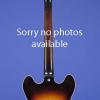A Fine and Rare Early-Sixties Esquire
This forty-two-year-old "L" series Esquire weighs just 6.90 lbs. and has a nut width of just under 1 11/16 inches and a scale length of 25 1/2 inches. Solid ash body and fretted maple neck with 21 frets and pearloid dot position markers. Single "butterfly" string tree. Headstock decal with "Fender" spaghetti logo in silver with black trim and "Esquire" in black below it. Individual "single-line" branded Kluson Deluxe tuners with oval metal buttons. Four-bolt neck plate with serial number ("L03475") at the top. One single-coil pickup, angled in bridgeplate, with an output of 6.60k. Single-ply white celluloid pickguard with eight screws. Two controls (one volume, one tone) plus three-way "tone" switch with "top-hat" tip, all on metal plate adjoining pickguard. Chrome knobs with flat tops and knurled sides. Telecaster/Esquire combined bridge/tailpiece with three steel saddles. Complete with its original "ashtray" bridge cover. The neck is stamped "3APR63B", and the pots are dated "3046315" (Stackpole, 15th week of 1963). Apart from a few tiny marks on the back. a few small chips on the edges, and some finish checking to the back of the neck, this remarkable example with it's original frets, is in totally original condition. Quite simply the best mid-sixties Esquire we have ever seen, complete with it's original 'Ashtray' bridge cover. Housed in its original Fender brown hardshell case with orange plush lining (8.75). The price in October 1966 was $169.50 for the guitar (a full $40.00 less than its Telecaster cousin)...plus a huge $52.50 for the case! This actual guitar is listed in Duchossoir The Fender Telecaster [1991] and also in Werner's List volume twenty-two [1998].
"Leo Fender's new solidbody was the instrument that we know now as the Fender Telecaster, effectively the world's first commercially successful solidbody electric guitar...The guitar was originally named the Fender Esquire and then the Fender Broadcaster, and it first went into production in 1950. It was a simple, effective instrument. It had a basic, single-cutaway, solid slab of ash for a body, with a screwed-on maple neck. Everything was geared to easy production. It had a slanted pickup mounted into a steel bridge-plate carrying three adjustable bridge-saddles, and the body was finished in a yellowish color known as blond. It was unadorned and like nothing else. It was ahead of its time (Tony Bacon, 50 Years of Fender, p. 10).
"After a false start the Esquire reappeared...in 1951, now with Fender's new adjustable truss-rod. It was offered in single-pickup format only, but otherwise was virtually identical to the two-pickup Telecaster. However, the Esquire's three-way selector functioned as a preset tone control or bypass switch, offering wide versatility from a one-pickup guitar. Perhaps surprisingly, the Esquire stayed in the line for 20 years" (Tony Bacon and Paul Day, The Fender Book, p. 10).
Translate:

